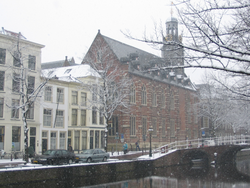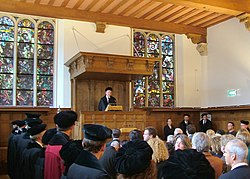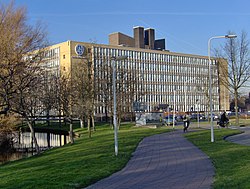| Universiteit Leiden | |
 | |
| Latin: Academia Lugduno Batava | |
| Motto: | Praesidium Libertatis (Bastion of Freedom) |
| Established: | 1575 |
| Type: | Public |
| Rector: | Paul van der Heijden |
| Faculty: | 3,973 |
| Students: | 17,630 |
| Location: | Leiden, the Netherlands |
| Website: | http://www.leiden.edu |
Leiden University (Dutch: Universiteit Leiden), located in the city of Leiden, is the oldest university in the Netherlands.[1] The university was founded in 1575 by Prince William of Orange, leader of the Dutch Revolt in the Eighty Years' War. The royal Dutch House of Orange-Nassau and Leiden University still have a close relationship. The Queens Juliana and Beatrix and crown-prince Willem-Alexander studied at Leiden University. In 2005 Queen Beatrix received a rare honorary degree from Leiden University.
Today, Leiden University has six faculties, over 50 departments and more than 150 undergraduate programmes, and it enjoys an international reputation. The Academic Ranking of World Universities ranked Leiden University 71st worldwide for 2007, 20th in Europe, and second in the Netherlands.The Times Higher Education 2008 ranked Leiden University 64th in the world overall. The university is a member of the Coimbra Group, the Europaeum and the League of European Research Universities.
Leiden University houses more than 40 national and international (research) institutes.
History

In 1575, the emerging Dutch Republic did not have any universities in its northern heartland. The only other university in the Netherlands was in southern Leuven, firmly under Spanish control. The scientific renaissance had begun to highlight the importance of academic study, so Prince William founded the first Dutch university in Leiden as a reward for the heroic defence of Leiden against Spanish attacks in the previous year. Ironically, the name of Philip II of Spain, William's adversary, appears on the official foundation certificate, as he was still the de jure count of Holland. It is traditionally said that the citizens of Leiden were offered the choice between a university and a certain exemption from taxes, and that the citizens believed that a tax law could be rescinded, whereas the great universities of Europe had survived for many centuries. Originally located in the convent of St Barbara, the university moved to the convent of the White Nuns in 1581, a site which it still occupies, though the original building was destroyed in 1616.
The presence within half a century of the date of its foundation of such scholars as Justus Lipsius, Joseph Scaliger, Franciscus Gomarus, Hugo Grotius, Jacobus Arminius, Daniel Heinsius and Gerhard Johann Vossius, at once raised Leiden university to the highest European fame, a position which the learning and reputation of Jacobus Gronovius, Herman Boerhaave, Tiberius Hemsterhuis and David Ruhnken, among others, enabled it to maintain down to the end of the 18th century.
At the end of the nineteenth century, Leiden University again became one of Europe's leading universities. At the world’s first university low-temperature laboratory, professor Heike Kamerlingh Onnes achieved temperatures of only one degree above absolute zero of -273 degrees Celsius. In 1908 he was also the first to succeed in liquifying helium and can be credited with the discovery of the superconductivity in metals.
Kamerlingh Onnes was awarded the Nobel Prize for Physics in 1913. Three other professors received the Nobel Prize for their research performed at Universiteit Leiden: Hendrik Antoon Lorentz and Pieter Zeeman received the Nobel Prize for their pioneering work in the field of optical and electronic phenomena, and the physiologist Willem Einthoven for his invention of the string galvanometer, which among other things, enabled the development of electrocardiography.
These Nobel prize winners, but also the physicists Albert Einstein and Paul Ehrenfest, the Arabist and Islam expert Christiaan Snouck Hurgronje, the law expert Cornelis van Vollenhoven and historian Johan Huizinga, were among those who pushed the university into a place of international prominence during the 1920s and 1930s. In 2005 the manuscript of Einstein on the quantum theory of the monatomic ideal gas (the Einstein-Bose condensation) was discovered in one of Leiden's libraries.
At present, Leiden has a firmly established international position among the top research institutes in many fields, including the natural sciences, medicine, social and behavioural sciences, law, arts and letters. Of the forty-eight Spinozapremie (the highest scientific award of The Netherlands), eleven were granted to professors of the Universiteit Leiden. Literary historian Frits van Oostrom was the first professor of Leiden to be granted the Spinoza award for his work on developing the NLCM centre (Dutch literature and culture in the Middle Ages) into a top research centre. Other Spinozapremie winners are linguists Frits Kortlandt and Pieter Muysken, mathematician Hendrik Lenstra, Carlo Beenakker, who works in the field of mesoscopic physics, Ewine van Dishoeck, astronomer at Leiden Observatory, transplantation biologist Els Goulmy, clinical epidemiologist Frits Rosendaal, Rien van IJzendoorn professor of education and child studies, physicist Jan Zaanen and archeologist Wil Roebroeks. Among other leading professors are Wim Blockmans, professor of Medieval History, and Willem Adelaar, professor of Amerindian Languages.
The portraits of many famous professors since the earliest days hang in the university aula, one of the most memorable places, as Niebuhr called it, in the history of science.
The University Library, which has more than 3.5 million books and fifty thousand journals, also has a number of internationally renowned special collections of western and oriental manuscripts, printed books, archives, prints, drawings, photographs, maps, and atlases. Scholars from all over the world visit Leiden University Library, the oldest in the Netherlands. The research activities of the Scaliger Institute focus on these special collections and concentrate particularly on the various aspects of the transmission of knowledge and ideas through texts and images from antiquity to the present day.
Among the institutions affiliated with the university are The KITLV or Royal Netherlands Institute of Southeast Asian and Caribbean Studies (founded in 1851), the observatory 1633; the natural history museum, with a very complete anatomical cabinet; the museum of antiquities (Museum van Oudheden), with specially valuable Egyptian and Indian departments; a museum of Dutch antiquities from the earliest times; and three ethnographical museums, of which the nucleus was Philipp Franz von Siebold's Japanese collections. The anatomical and pathological laboratories of the university are modern, and the museums of geology and mineralogy have been restored.
The Hortus Botanicus (botanical garden) is the oldest botanical garden in the Netherlands. Plants from all over the world have been carefully cultivated here by experts for more than four centuries. The Clusius garden (a reconstruction), the 18th century Orangery with its monumental tub plants, the rare collection of historical trees hundreds of years old, the Japanese Siebold Memorial Museum symbolising the historical link between East and West, the tropical greenhouses with their world class plant collections, and the central square and Conservatory exhibiting exotic plants from South Africa and southern Europe.
Research at Leiden is well developed. There are many university research institutes and Leiden participates in over forty nation-wide research schools, twelve of which being located in the heart of Leiden.
The institution


The university has no central campus; its buildings are spread over the city. Some buildings, like the Gravensteen, are very old, while buildings like Lipsius and Gorlaeus are much more modern. The university is divided into six major faculties which offer approximately 50 undergraduate degree programs and over 100 graduate programs.
Education
Undergraduate programs
Most of the university's departments offer their own degree program(s). Undergraduate programs lead to either a B.A., B.Sc. or LL.B. degree. Other degrees, such as the B.Eng. or B.F.A., are not awarded at Leiden University.
| Faculties | |
|---|---|
| Humanities | Website |
| Law | Website |
| Medicine or LUMC | Website |
| Mathematics and Natural Sciences | Website |
| Social and Behavioural sciences | Website |
| Archaeology | Website |
|
|
Graduate Studies
Students can choose from a range of graduate programs. Most of the above mentioned undergraduate programs can be continued with either a general or a specialised graduate program. Leiden University offers more than 100 graduate programs leading to either M.A., M.Sc., M.Phil., or LL.M. degree. The M.Phil. is a special research degree and only awarded by selected departments of the university (mostly in the fields of Arts, Social Sciences, Archeology, Philosophy, and Theology). Admission to these programs are highly selective and primarily aiming at those students opting for an academic career.

Some of the notable graduate programs are
- Air and Space Law
- Asian Studies
- Bioinformatics
- Chemistry
- Industrial Ecology Msc (track)
- DNA computing
- Drug Delivery Technology and Biopharmaceutics
- European Law
- European Business Law
- European Union Studies
- Evolutionary and Ecological Sciences
- Functional Genomics
- History
- ICT in Business
- Public International Law
- International Relations and Diplomacy
- Islamic Studies
- Life Science and Technology
- Linguistics
- Media Technology[26]
- Nanoscience
- Philosophy of a Specific Discipline
- Toxicology
Doctorate programs
In addition, most departments, affiliated (research)institutes or faculties offer doctorate programs or positions, leading to the Ph.D degree. Most of the Ph.D. programs offered by the university are concentrated in several research schools or institutes.
Research schools and affiliated institutes
Leiden University has more than 50 research and graduate schools and institutes. Some of them are fully affiliated with one faculty of the university, while others are interfaculty institutes or even interuniversity institutes. Most of the scholars working in the Netherlands are associated with one of these schools or institutes.
| Institute | |
|---|---|
| ASC | Research Centre for African Studies |
| CNWS | Research School of Asian, African, and American Studies |
| CRC | Crisis Research Centre |
| CTI | Center for Language and Identity |
| E.M. Meijers Institute | Research School for Legal Studies |
| eLaw@Leiden | Centre for Law in the Information Society |
| Grotius Centre | Research Centre for International Legal Studies |
| GSS | Leiden Graduate School of Science |
| Historical Institute | Research Institute of History |
| Huizinga Instituut | Research Institute and Graduate School of Cultural History |
| IBL | Research Institute for Biology |
| IIAS | International Institute for Asian Studies |
| IOPS | Interuniversity Graduate School Psychometrics and Sociometrics |
| ISED | Institute for the Study of Educational and Human Development |
| LACDR | The Leiden Amsterdam Center for Drug Research |
| LCMBS | Leiden Centre for Molecular BioScience |
| LGSAS | Leiden Graduate School for Archeology |
| LIACS | Leiden Institute of Advanced Computer Science |
| LIBC | Leiden Institute for Brain and Cognition |
| LIC | Leiden Institute of Chemistry |
| LION | Leiden Institute of Physics |
| LISOR | Leiden Institute for the Study of Religion |
| LUCL | Leiden University Centre for Linguistics |
| LUMC | Leiden University Medical Centre |
| LUMI | Leiden University Mathematical Institute |
| Mediëvistiek | Netherlands Research School for Medieval Studies |
| NIG | Netherlands Institute of Government |
| NOVA | Netherlands Research School for Astronomy |
| N.W. Posthumus Instituut | Netherlands Research Institute and School for Economic and Social History |
| OIKOS | National Graduate School in Classical Studies |
| Onderzoekschool Kunstgeschiedenis | Dutch Postgraduate School for Art History |
| OSL | Netherlands Graduate School for Literary Studies |
| PALLAS | Research Institute of Art History and Literatures of the Western World |
| Polybios | Graduate School for Political Science and International Affairs |
| Sterrewacht Leiden | Leiden Astronomical Observatory |
| The Europa Institute | Research Institute for Legal Studies in the Field of European Integration |
| Van Vollenhoven Institute | Research Institute for Law, Governance and Development |

No comments:
Post a Comment